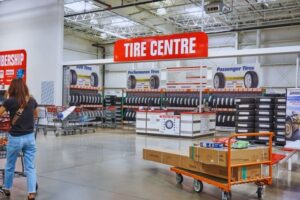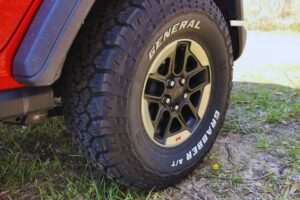Different tire wear patterns allow you to identify how your tires connect with the pavement. It tells you if you merely need a new set of tires or if other issues affect your tire’s life. What are the different tire wear patterns, and what do they mean?
The most common tire wear patterns include tire tread wear on the center, tire tread wear on the sides, and feather edge tire wear. Other tire wear patterns include one-sided tire wear on the shoulders, patchy wear patterns, and little dips on the tread.
Tire wear can be associated with other car issues. It can mean that your car has alignment issues, a problem with the bushings, or has bad springs.
Read on to learn more about tire wear patterns and what they mean.
Tire Wear Patterns and What They Mean
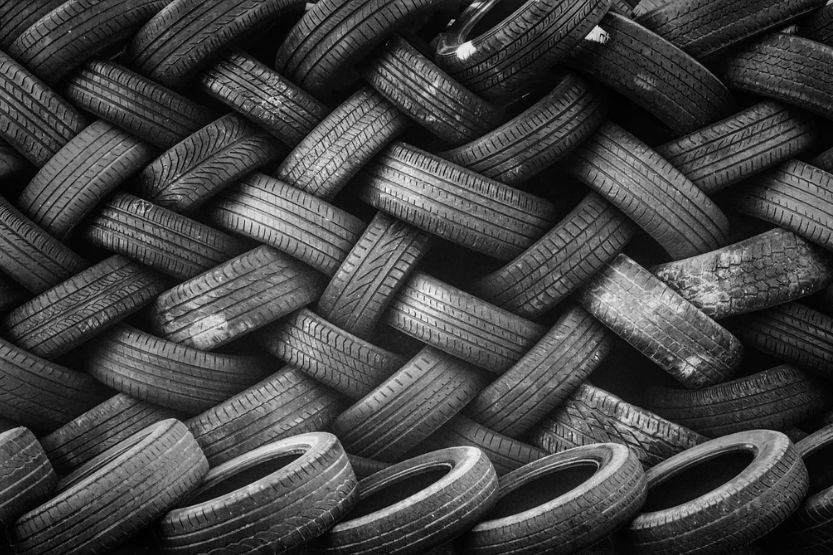
The tire wear patterns include tire tread wear on the sides, tire tread wear on the center, and feather edge tire wear. It also includes little dips on the tread, patchy wear patterns, and one-sided tire wear on the shoulders.
It is understandable how prone tires are to wear and tear. They bear the entire weight of a vehicle. They also get direct contact with the road. If you drive on rough roads most of the time, it will most likely hasten your tires’ tear rate.
However, other scenarios hasten the life of your tires. Tire wear can be associated with other car issues. This means that your car probably has alignment issues, a problem with the bushings, or has bad springs, among others.
Tire Wear Patterns Guide
It is advantageous to be familiar with the different car tire wear patterns. This is particularly true if you’re a mechanic or a car enthusiast.
So, here’s a tire wear patterns guide for you. This includes the following:
- Tire Tread Wear on the Sides
- One-sided Tire Wear on the Shoulders
- Tire Tread Wear on the Center
- Feather Edge Tire Wear
- Little Dips on the Tread
- Patchy Wear Patterns
Let’s talk about these patterns and their corresponding meaning:
1. Tire Tread Wear on the Sides
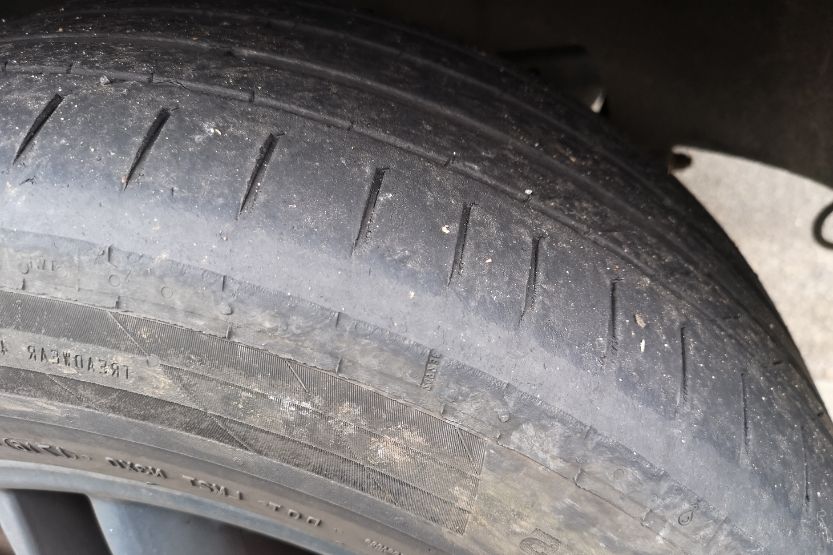
If there’s tire tread wear on the sides, it means your tires are poorly inflated. The sides of the tires bear the entire weight of the vehicle. This then results in deterioration.
Unbalanced tires can also result in tire tread wear on the sides. So, make sure that your tires are evenly inflated.
2. One-sided Tire Wear on the Shoulders
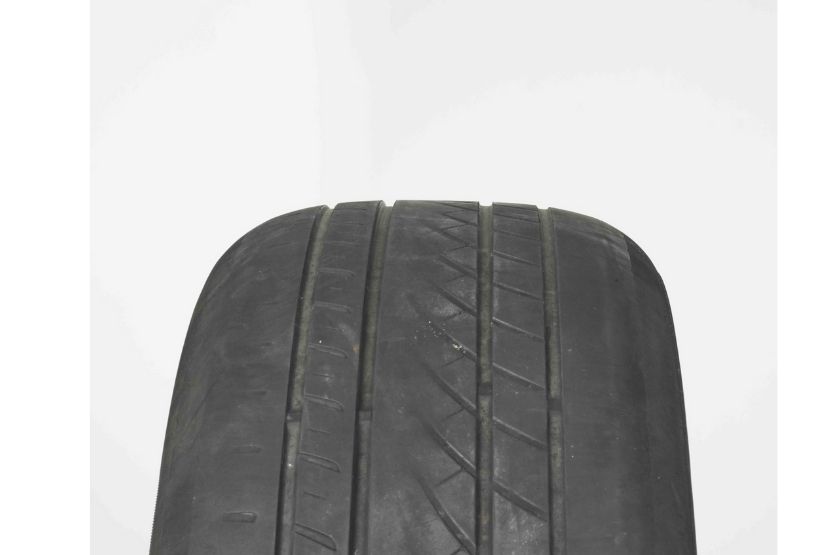
A one-sided tire wear on the shoulder indicates excessive camber.
Camber refers to either the inner or outer tire angle from the front or rearview. It is common among sports and modified cars featuring a lower clearance.
If there is excessive inward angling of the tires, it is called negative camber. At the same time, the outward angling of the tires is called positive camber. Cambering can result from too much load or a faulty suspension system.
3. Tire Tread Wear on the Center
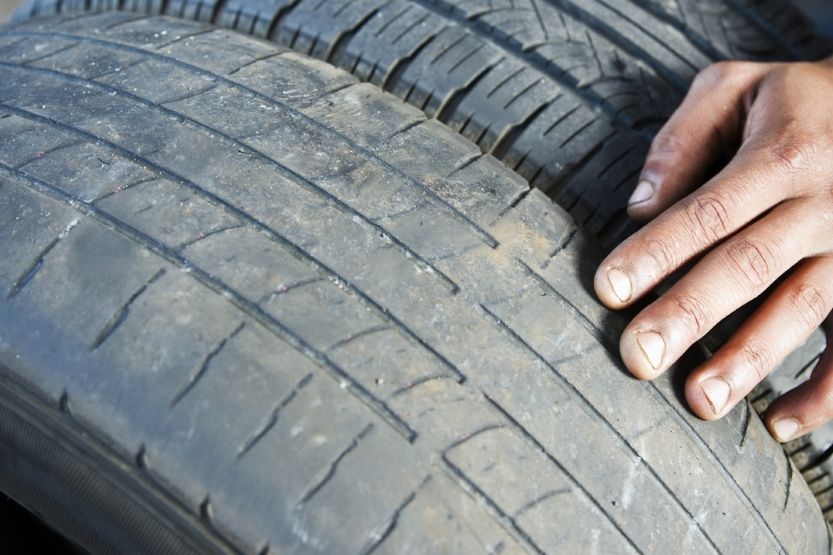
This is one of the most common patterns encountered by drivers. This pattern results from overinflation.
A tire that is excessively inflated will most likely ride by the central treads. The wear will then be concentrated on that part every time the car is on the road.
To prevent this from happening, make sure that the wheels are correctly inflated.
4. Feather Edge Tire Wear
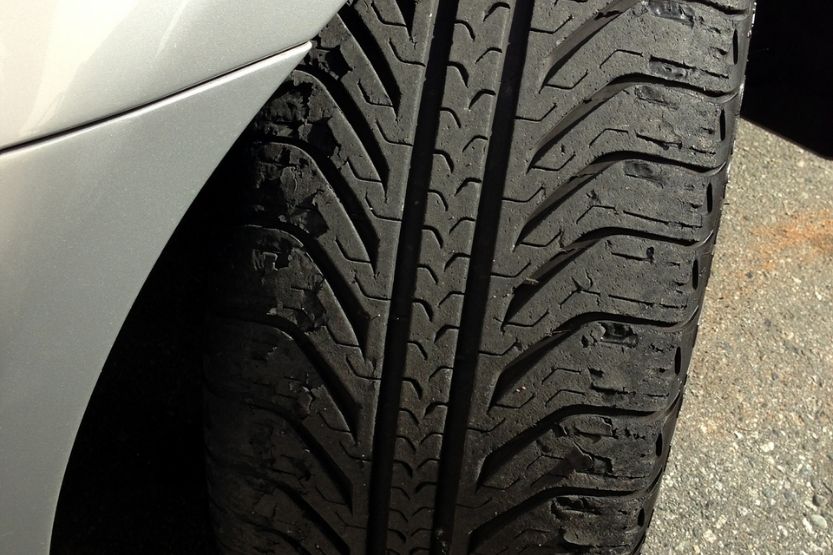
You have probably encountered having tires with a smooth edge then lifts on the other. This is called feather edge tire wear.
Feathering occurs if there is a problem with the alignment settings. It happens when there is an excessive positive toe or an excessive negative toe. Basically, it all boils down to having poor alignment settings.
The toe-out tire wear is generally the same as the feather edge tire wear. This occurs because the shoulder ribs wear out fast. Excess positive or negative toeing is the major cause of this issue.
5. Little Dips on the Tread
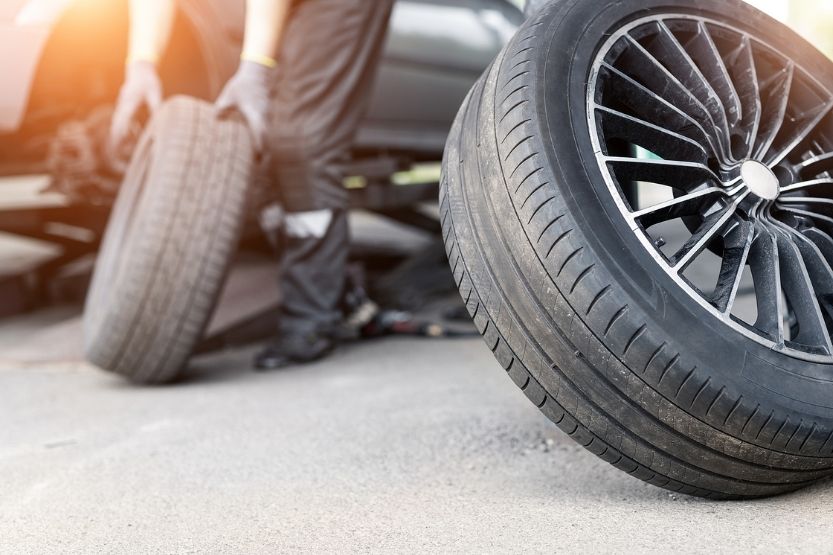
If your car has a poor suspension system, this will affect the tires. Little dips will form on the treads. When you notice this, it’s best to check your car’s shocks and springs immediately. Then, address the issues as soon as possible.
6. Patchy Wear Patterns
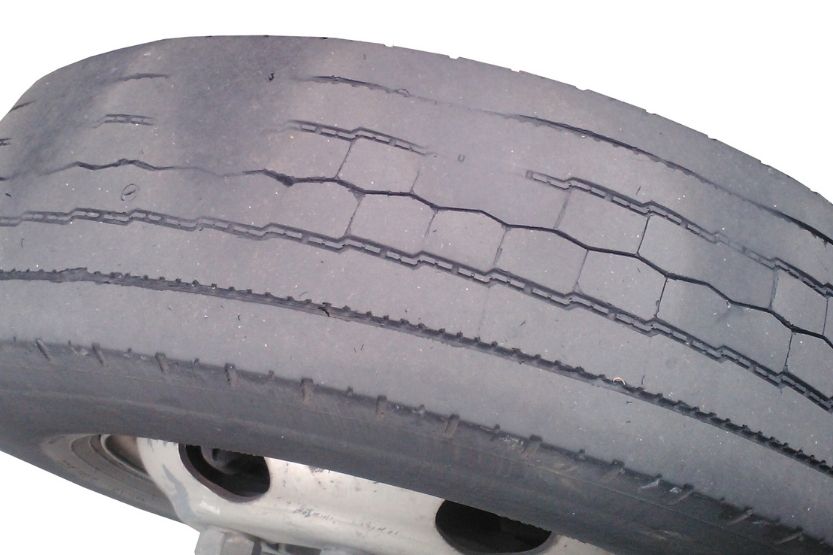
Unbalanced wheels cause patchy tire wear patterns. Some patches are even bigger or deeper than others. This is similar to the diagonal wear pattern, which also results from unbalanced wheels.
To address this particular issue, bring your car to a car care shop for a tire rotation.
Truck Tire Wear Patterns
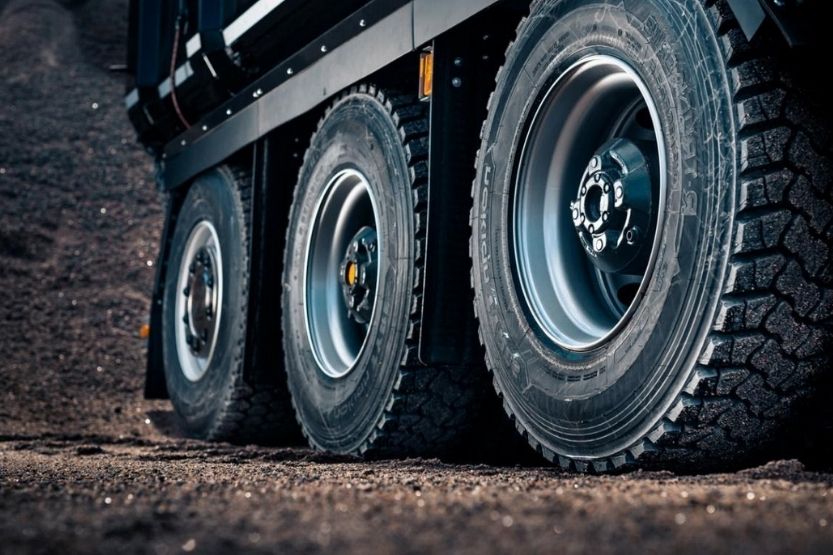
Car tire wear patterns are generally the same as truck tire wear patterns. But there are also truck tire conditions that are distinct from other types of vehicles.
There are different truck tire conditions. These include Irregular Drive Tire Conditions, Irregular Trailer Tire Conditions, and Irregular Steer Tire Conditions. Under these tire conditions are different truck tire wear patterns:
Irregular Drive Tire Conditions
Irregular drive tire conditions include the following:
- Multiple Cuts or Chunking
- Vehicle or Spin Damage
- Brake Skid Damage
- Stone Retention or Drilling
- Heel or Toe Wear
- Scallop / Cupping / Alternate Lug Wear
1. Multiple Cuts or Chunking
When we say multiple cuts or chunking, the tires have several small cuts to the tread surface. At times, some portions of the tread are removed, which then gives a rough appearance.
This generally occurs when the tires are often in contact with rough surfaces. To fix this issue, it is recommended to review your tire selection and operation. Always choose tires that are appropriate for your type of truck operation.
Minor damages can still be addressed. If the tires need further repairs and retreading, it is best to consult someone who can retread your tire.
2. Vehicle or Spin Damage
If there are cuts or lines around the tire, there’s probably vehicle or spin damage. This occurs when the tires are often in contact with other vehicle components. Most of the time, these components include bumpers or mud flap brackets. However, if the tires spin on ice or loose road surface, it results in cuts or lines.
Bring the truck to a vehicle care service if the cause involves the bumper, mud flap brackets, or other truck components. If it involves ice or road surfaces, it is best to review driving practices.
3. Brake Skid Damage
When we say brake skid damage, the tires have a localized spot of excessive wear across the tread face. This indicates abrasion marks, and there’s a tendency for the damage to extend into the casing.
There are several reasons why this happens. It can be because of the new brakes, but it can also be due to the unbalanced brake system. Brake skid damage can also result from frozen brake lines or driver abuse.
To correct this, check the brake system. If the issue is addressed immediately, the tires can still be repaired or retreaded. Otherwise, your tires may already need replacement.
4. Stone Retention or Drilling
If the tire has stone retention or drilling condition, it means there are stones or gravel embedded in between the tread blocks. There are times when these stones even reach the steel cables.
This condition is common in truck tires, particularly those operating on gravel surfaces. But it can also mean overinflation or misapplication of the tire.
You can prevent this from occurring often if proper tire inflation pressures are maintained.
5. Heel or Toe Wear
If there’s heel or toe wear, each lug around the tire is worn high to low, starting from front to back edge. This occurs when there’s a mismatched inflation pressure or unbalanced tire diameters in a dual assembly.
It also occurs when there are mountainous terrains, during high torque conditions, and when there’s high inflation pressure.
To prevent this from occurring, it’s best to apply tire maintenance practices at all times. Also, get a recommendation from a tire manufacturer. Ask what the best type of tire for your truck is.
6. Scallop / Cupping / Alternate Lug Wear
If this condition happens, there are localized cupped-out areas of fast wear all over the tire. Alternate lugs are also worn at various tread depths all over the tires.
This usually results from a mismatched tire inflation pressure. It can also result from mismatched tire diameters in a dual assembly and poor suspension components.
It’s best to have the truck tires checked by a professional mechanic.
Irregular Trailer Tire Conditions
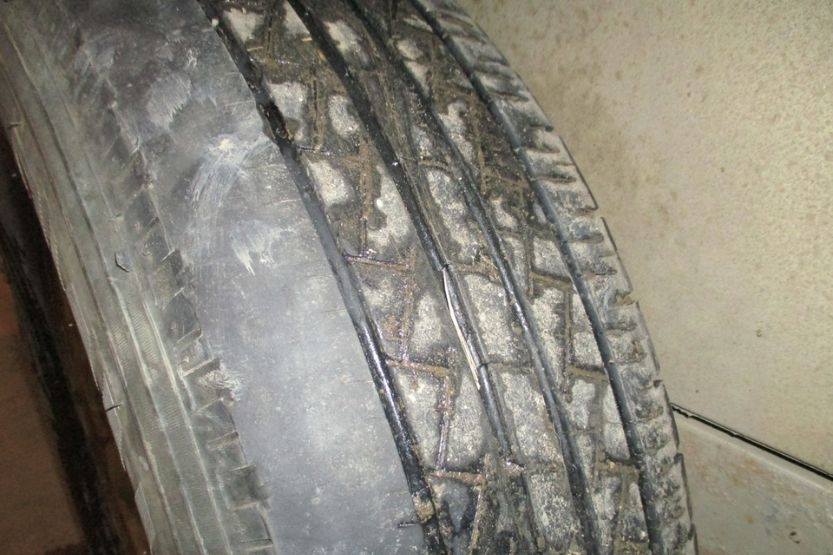
Brake skid damage and cupping/scallop wear also form part of irregular trailer tire conditions. Aside from that, it includes the following:
- Intermediate Depression Wear
- Shoulder Depression Wear
- Diagonal Wear
- Shoulder Step Wear
1. Intermediate Depression Wear
When there’s intermediate depression wear, one or more interior ribs are worn beneath the adjacent ribs all over the tire’s circumference. But this does not include the center of the ribs.
There are several reasons for this occurrence. It can be due to mismatched dual-diameter or inflation pressures, improper bearing adjustment, or underinflation. Worn suspension components are a factor too. The condition is further aggravated by high speed and light loads.
2. Shoulder Depression Wear
When there’s shoulder depression wear, there are localized areas of wear in the shoulder. Typically, it measures less than 12 inches in length.
The probable causes for this tire condition include mis-mounted tires on wheels or improper tire inflation pressure. Other types of wheel-end imbalance can result in shoulder depression wear too.
3. Diagonal Wear
If there is a diagonal wear pattern, the localized flat spots are worn diagonally across the tread. This may result from inflation pressure or mismatched dual tire diameter. Misalignment and improper bearing adjustment are probable causes too.
4. Shoulder Step Wear
If there’s shoulder step wear, the tires are worn on the edge of one shoulder. Typically, the damage measures inches in circumference.
This may occur due to excessive camber, improper bearing adjustment, or damaged or misaligned axle.
Irregular Steer Tire Conditions
Irregular steer tire conditions include shoulder step wear, one-sided wear, and intermediate depression wear. It also includes diagonal wear, feather wear, and shoulder depression wear. However, it also includes the following conditions:
- Erosion / River Wear
- Multiple Flat Spotting Wear
- Center Depression Wear
1. Erosion or River Wear
When there’s erosion or river wear, the tire’s circumferential worn area is located on the sides of the tread ribs.
This condition is common on slow-wearing radial tires in a trailer or a steer position. In other words, the tires are free rolling.
2. Multiple Flat Spotting Wear
Multiple flat-spotting wears is the condition when there are multiple radially worn areas all over the tires. This results from severe balance issues, worn or loose wheel bearings, or faulty shocks. Other times, it results from the excessive high-speed empty operation, mismatched tire diameters, or mismatched tire pressures.
3. Center Depression Wear
Under this condition, the circumferential depression wear is found on the center of the tread rib. This may be caused by high-speed empty haul conditions, mis-mounted tires on wheels, or loose wheel bearings. It can also result from faulty shocks, underinflation, or overinflation.
What Happens If You Flatten a Tire with a Knife?
Retreading and Recycling Tires
Retreading
When a tire loses its tread, most commercial drivers prefer retreading. It does not only help them save money, but it also helps them save resources.
A retreaded tire consists of 75% recycled materials. At the same time, a new tire consists of 2% recycled materials only.
Retreading also makes use of oil measuring 7 gallons only. On the contrary, new tires make use of 22 gallons.
Retreaded tires are common not only for commercial trucking fleets. They are common for airplanes and school buses too.
Recycling
Once truck tires become totally worn out, they can still be recycled for other uses. In the United States, the ratio of scrap tires per driver is 1:1. A maximum of 40% of these scrap tires is used in industrial settings as fuel, such as in boilers or power plants.
Scrap tires may also be recycled for agricultural purposes, for exports, as shredded rubber, and for engineering projects.
Conclusion – Tire Wear Patterns and What They Mean
The tire wear patterns include tire tread wear on the sides, tire tread wear on the center, and feather edge tire wear. It also includes little dips on the tread, patchy wear patterns, and one-sided tire wear on the shoulders.
In most cases, we attribute tire wear to how drivers use their vehicles. It can be because they are not applying correct driving practices. Some even abuse their vehicles.
However, there are cases when tire wear is only the impact of other vehicle issues. For instance, the tires that constantly touch the mud flap bracket or the bumper will most likely get worn out. Tire wear can also be linked to steering issues.
This is why it’s important to familiarize yourself with the different tire wear patterns. That way, it becomes easier to pinpoint the root cause in case you encounter it with your own vehicle.
Related reading:
Walmart Tire Installation Cost [How Much Do They Charge?]
Wheel Bearing Replacement Cost [Front or Rear]
Scratched Rims Repair Cost [How Much to Fix a Scratched Rim?]

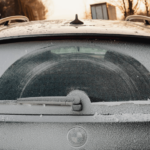

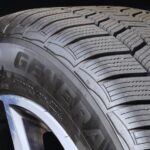
![MS-6395 Oil List [What are They and Their Benefits] MS-6395 Oil List](https://roadsumo.com/wp-content/uploads/2021/12/MS-6395-oil-list-150x150.jpg)


![Read more about the article Walmart Tire Rotation Cost [What Does Walmart Charge?]](https://roadsumo.com/wp-content/uploads/2021/07/walmart-tire-rotation-cost-300x200.jpg)
